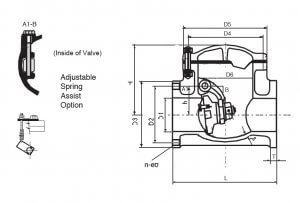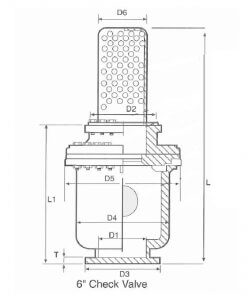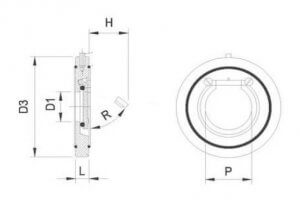Check Valves: What You Need to Know
The Year of the Check Valve
Check valves—also sometimes called one-way or non-return valves—play a vital role in the fluid handling systems of a wide range of industries. By limiting the flow of fluid through a system to a single direction, they eliminate the risk of backflow, overflow, or other conditions that can cause damage to upstream equipment, such as other valves, pipes, and pumps.
While these components have long served as key elements in hydraulic and pneumatic operations, new market predictions suggest that they may become even more ubiquitous. A report from Mordor Intelligence provides a snapshot of the control valve market (which includes check valves) that indicates estimated growth of USD 2.07 billion from 2020 to 2026 at a compound annual growth rate (CAGR) of 3.67%. This forecast, combined with recent increases in infrastructure and pipeline development investments and valve technology-monitoring technology integrations, may signal the beginning of the year(s) of the check valve.
How Does a Check Valve Work?
Check valves are one of the simplest types of directional control valves. They allow fluid to flow in one direction while preventing it from flowing in the opposite direction. At their most basic, they consist of an inlet port and an outlet port. A difference in pressure between the two ports allows the valve to open and close. When the pressure on the inlet side is greater than the pressure on the outlet side, the valve opens. When the pressure on the inlet side is lower than the pressure on the outlet side or not high enough to keep the valve open, the valve closes.
While the mechanism used to open and close the valve can vary depending on the type of check valve, each one is self-automated. This means the valve can operate without user involvement. Additionally, they do not require electricity, which enables them to continue to work even if the power fails within the facility.
Two of the most common types of check valves are ball check valves and swing check valves.
- Ball check valves use a spherical ball inside a cylindrical chamber with a conical opening. The ball moves forward when the flow is moving forward, which allows fluid to pass through to the next chamber. The ball moves backward when the flow is moving backward, which prevents fluid from passing through to the previous chamber.
- Swing check valves use a spring-mounted disc. The spring expands when the flow is moving forward, which allows the disc to move forward and the fluid to pass through to the next chamber. The spring compresses when the flow is moving backward, which pushes the disc backward and prevents fluid from passing through to the previous chamber.
Each of the check valve variations offers unique advantages and disadvantages that make it suitable for particular applications. For example, ball check valves are generally only used for liquid systems, while swing check valves are used for both liquid and gas systems.
Why Are Check Valves Important?
Check valves are a simple way to achieve and maintain the safe flow of fluids within a system. As they allow for flow in only one direction, they protect equipment from damage caused by backflow. Additionally, they help maintain constant system pressure, which can lead to more efficient and effective operations. For these reasons, they’re regularly used in fluid handling systems for a variety of industries and industrial applications.


What Industries Are Seeing Increased Need for Check Valves?
As per the Mordor Intelligence report, the need for control valves, including check valves, is expected to increase drastically between 2020 and 2026. One of the key factors driving this growing demand is the recent and future expansions of various industries. These changes are expected to lead to an increased need for check valves.
Below, we highlight some of the industries that will likely see this increased need. Some of which overlap with the industries we have experience working with.
- Water Treatment: In the Asia-Pacific region, growing populations necessitate investment in more water and wastewater facilities. Both of these facilities rely on check valves and other control valves for their operations.
- Landfills: While landfills have historically depended on butterfly valves for their operations, they’ve recently begun using swing check valves due to their lower price point.
- Oil and Gas: In an effort to increase oversight and control over operations, the oil and gas industry has begun investing in more advanced valve technology (e.g., with embedded processors and networking capabilities).
- Pharmaceuticals: By utilizing newer valve technologies, pharmaceutical manufacturers can decrease equipment ownership costs, increase uptime, and reduce maintenance costs. Additionally, they can achieve and maintain greater control over their operations.
- Alternative Energy: The push for sustainability in recent years has led to the construction of more and more renewable energy plants. Many of the operations within these facilities rely on control valves.
Choose TVI for Your Check Valve Needs
Check valves are an essential component of many fluid handling and processing applications. Given their critical function, it is important to select the right type from the right supplier. Otherwise, your operations may be at risk. If you need a reliable provider of quality check valves, TVI has your back.
At TVI, we are a leading provider of quality valves and valve accessories. We maintain an extensive selection of products to suit different customer needs. Our check valve offerings include:
- Ball Check Valves: Our ball check valves feature all thermoplastic construction. The body has full-length ribs that are designed to maximize flow, minimize pressure drop, and eliminate ball chatter and sticking, while the seat is full-circle and resilient. They are available in sizes ranging from ¼ inch to 4 inches and 6 inches to 10 inches.
- Swing Check Valves: Our swing check valves have molded thermoplastic bodies, disc assemblies, bonnets, and shafts. They do not accommodate metal internals and do require low back pressure for drop-tight sealing. They are available in sizes ranging from ¾ inch to 8 inches.
- Wafer Check Valves: Our wafer check valves feature plastic bodies, flappers, and mounting screws and elastomeric O-ring seals. They are compact and easy-to-install in horizontal or vertical configurations. They are available in sizes ranging from 1 ½ inches to 20 inches.
To learn more about these products, check out our ball check valves, swing check valves, or wafer check valves pages. For assistance choosing one for your application, contact us today.


